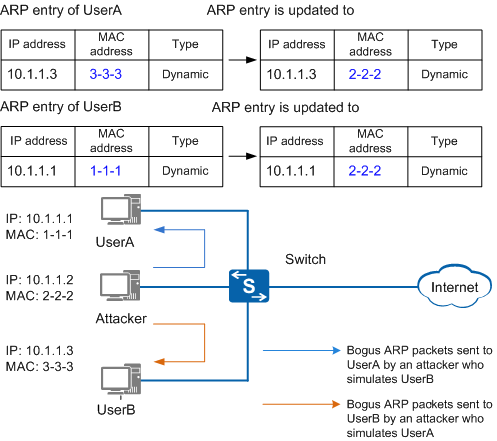DAI
A man-in-the-middle (MITM) attack is a common ARP spoofing attack.
An MITM attacker establishes connections with two ends and exchanges data between them. The two ends consider that they are directly communicating, but actually the attacker has controlled the entire session. In an MITM attack, the attacker intercepts all packets going between the two ends and inserts new ones.
Figure 1 shows an MITM attack scenario. An attacker poses as UserB to send a bogus ARP packet to UserA. UserA then records an incorrect ARP entry for UserB. The attacker easily obtains information exchanged between UserA and UserB. Information between UserA and UserB is not protected or secure.
To defend against MITM attacks, configure dynamic ARP inspection (DAI) on the Switch.
DAI uses a DHCP snooping binding table to prevent MITM attacks. When the switch receives an ARP packet, it compares the source IP address, source MAC address, interface number, and VLAN ID of the ARP packet with binding entries. If the ARP packet matches a binding entry, the switch considers the ARP packet valid and allows the packet to pass through. If the ARP packet does not match a binding entry, the switch considers the ARP packet invalid and discards the packet.

This function is available only when DHCP snooping is configured. The device enabled with DHCP snooping generates DHCP snooping binding entries when DHCP users go online. If a user uses a static IP address, you need to manually configure a static binding entry for the user. For details about DHCP snooping, see DHCP Snooping Fundamentals.
When an attacker connected to the Switch enabled with DAI sends bogus ARP packets, the Switch detects the attacks based on the binding entries and discards the bogus ARP packets. When both the DAI and packet discarding alarm functions are enabled on the Switch, the Switch generates alarms when the number of discarded ARP packets matching no binding entry exceeds the alarm threshold.
